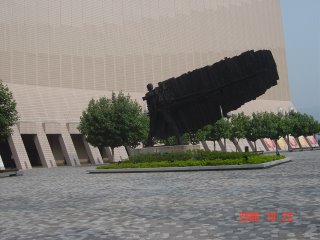 Semiotic Diagram by Gogo Tsang
Semiotic Diagram by Gogo Tsang"Is Taiji a martial art?"
"The movements of taijiquan are too slow. How can I use it to defend myself?"
"I know that taiji is powerful, but why can't I make use of its techniques in self-defence after practising it for so many years? Should I go to the gym to train up my muscles? Should I try hitting sand bag?"
These are questions frequently asked by the "taiji beginners".
Taijiquan practitioners are all familiar with the stories of Yang Lu Chen learning Taijiquan in the Chen Village and how he became the teacher of the princes and generals in the Royal Palace. It was said that Yang Lu Chen and his two sons (and his grandsons) were great taijiquan fighters and no one could defeat them at their time.
Nowadays, many people practise the taijiquan form(s) but most of them do not know how to apply the form(s) in action.
We have to understand that the taijiquan form is only one of the essential elements in the taiji martial art system. In order to become a real taiji martial artist, one has to undergo a series of hard training so that his body condition is fit enough to learn and apply the techniques. This is a really difficult task and it requires a practitioner to invest significant time and effort. Further, the teacher's effort is required to loosen up the joints - your body condition is the end product of your teacher's effort!
There should be no secret in this.
Bad art drives out the goodThis is a strange world:
I did actually see a "taiji teacher" telling his students that they can utilise the taiji power and techniques by only practising the taijiquan form everyday.
"You will gradually know how to apply the techniques by doing the form day after day. You will be able to fight rightly in the taiji way instinctively, " said the "taiji teacher"..............
I have also seen people investing their money, time and effort to learn the "true" and "rare" taijiquan form(s), dreaming that they will become a grand master some day - probably they will take part in some taijiquan form competitions, win a couple of gold medals, and start a new school of taiji.
Perhaps this phenomenon is another exemplification of the economic theory of "Bad money drives out the good".
Purposes of doing the form
What then are the purposes of doing the taijiquan form(s)?
Here are some of them:
1. For body and mind coordination: The form was designed to enable movement of the human body in a coordinated and efficient manner. When you move your hands in a taijiquan action, your legs and your spine are usually moving correspondingly in support as well. You mind is trained to move many parts of your body in one go.
The guiding principle behind the first aspect is the maximisation of the efficiency of the human body:
(a) If you can do a task by using one ounce of strength, you should use one ounce only, nothing more and nothing less - save your energy. A correct and balanced body structure will assist you to best utilise your strength.
(b) A group of weak mucles working together could be more powerful than the force produced by an individual piece of strong muscle.
2. For recovery from injuries and illness (internal and external): the slow and coordinated movements of taijiquan enhance the self-recovery mechanism within a human body. If a practitioner gets hurt in a contentious practice, the teacher will encourage him to do the taijiquan form to enhance the recovery process. The slow motion form is a form of "chi" exercise which enhance your intrinsic power. With suitable breathing rhythm, the external movements activate the movements of the internal organs, fostering recovery from diseases caused by mental stress, over drinking, over smoking or lack of exercises.
3. To enable the students to remember the application techniques: There are various styles of taijiquan and each style has its own small circle and big circle forms. Each form embodies a separate genre of fighting techniques. Some on joint locks, some on throwing, some on striking. These techniques make good use of leverage, take advantage of centripetal and centrifugal, and most importantly apply the yin / yang conversion principle. The forces utlised in Taiji Martial Art are completely different from the power acquired through sand bag hitting or weight lifting. The techniques are jealously guarded and seldomly taught (you are not able to study them through any published material). Many of them are impracticable without the support of the required body condition. These techniques are exercised beautifully but the damage done on an opponent could be horrible. They are the results of profound researches on the human bodies. In action, a taiji martial artist's movement is very fast.
Morning Exercise and HealthFor those who wish to obtain good health by practising the taijiquan form(s), the first and the second aspects are very useful.
The first aspect trains a practitioner to keep a good control of his body and learn how to maintain his balance (reducing the chance of falling down due to lose of balance on slippery floor). While the muscles power of a practitioner is not strong, he can still be active if muscles in different parts of his body can work together in carrying out a task.
The usefulness of the second aspect is self-explanatory. It has been proved by many researches that the taijiquan form helps to speed up the recovery processes of patients, in particular from resporatory or gastial diseases.
For health purposes, a good understanding of the first 2 aspects should be sufficient. However, one should note that training of the form in these two aspects alone is not qualified or adequate to be regarded as martial art training - Up to this point, the form can only be regarded as a kind of "morning exercises". One has to note that, without going through the training in the
"Know Your Own Self Stage", the level of body and mind coordination acquired through doing the form alone is low. Such level of coordination is sufficient for normal daily activities but inadequate for martial art applications.
How about learning the third aspect?
Appreciation of the ArtFor health purpose alone, a morning exerciser need not learn the application techniques. As mentioned earlier, it is very difficult to put the techniques into practise without the support of the required body condition. Having said that, I would say that it is a pleasure to have a good understanding of the application techniques embodied in the taiji form.
Appreciating the applications is different from putting the applications into practice. It is similiar to the appreciation of artworks.
In order to appreciate the quality of a great painting, you need not be an artist or a painter yourself. Not every art museum visitor wants to become a painter. But in order to be able to truely appreciate the quality of a great painting, some basic understanding of the drawing techniques is essential.
With this in your heart, the taijiquan you practise in the morning will no longer be an "Empty Form".
EpilogueMartial Art and health appear to be conflicting. Real Taiji involves destructive techniques and cannot be considered as a healthy activity - there are also chances of getting hurt during training, which is unavoidable if you want to acquire the skills. On the other hand, morning exercise is not qualified to be a martial art training. I have therefore brought in the element of Appreciation as a balance, in contrast to the "Taiji Teacher" I met previously.
So we have the following elements in the semiotic diagram above:
1. The Taiji Martial Art;
2. The Taiji Martial Art Appreciation;
3. The Taiji Morning Exercise; and
4. The "Taiji Teacher"
[Click on the links below to see previous discussions on:
1.
Movement in Stillness;
2.
Stillness in Movement;
3.
Bamboo and Mercury; and
4.
Occupying the centre.]
.














